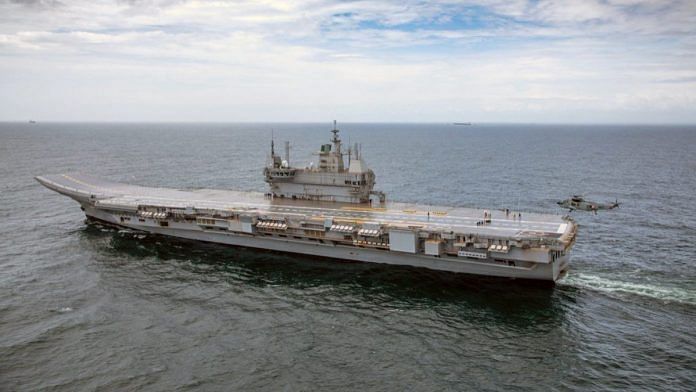It was truly a proud moment for India when its first Indigenous Aircraft Carrier, Vikrant, began her maiden sea trials on 4 August. The new Vikrant, a reincarnation of its earlier version by the same name, starts its journey in the 50th year of Bangladesh’s liberation in 1971, in which INS Vikrant had played a significant role. Expected to be commissioned in 2022, Vikrant will be the second aircraft carrier after the Russian-built INS Vikramaditya, which was commissioned in 2013. The third one, INS Vishal, and India’s second indigenous aircraft carrier, is likely to be delayed due to a number of factors. But one hopes the Navy will have enough freedom and budget to own that one as well, which would be around the same size as that of China’s warship.
India needs to seriously consider military modernisation at a much faster pace. The current weapons procurement system needs overhauling and be decoupled from bureaucratic wrangling and the L1 tender system as has been suggested by many, including Army Chief General M.M. Naravane.
Both the Indo-Pacific and the South China Sea are increasingly becoming contentious and regions of power posturing, contest and conflict. The US has launched a massive naval and amphibious military exercise in the Indo-Pacific region along with the UK, Australia, and Japan. This is besides the Quad activities that are in progress.
Moreover, the US Navy successfully tested and validated the systems integration and the missile’s propulsion system of the new AGM-88G Advanced Anti-Radiation Guided Missile-Extended Range (AARGM-ER), just ten days before the Indian Navy tested the Vikrant’s sea-faring systems. The US Navy is in the process of integrating AARGM-ER on the F/A-18E/F Super Hornet and EA-18G Growler aircraft as well as the Air Force F-35A, Marine Corps F-35B and Marine Corps F-35C aircraft. This Air Force-Navy technological coordination will enhance the US Navy’s capabilities to meet surface-to-air threats, especially in the South China Sea, where the US seeks to challenge China’s intrusions and claims.
Also read: From INS Vikrant to INS Imphal, how names of Indian Navy ships have evolved over the years
Lessons for India as China builds
China, not the least to be caught off guard, already has two aircraft carriers in service. At 65,000 tons each, they are larger than India’s two carriers. The first, an unfinished Russian ship, Type-001 Liaoning, was commissioned in 2012. China’s indigenously built second carrier, Shandong, with a slightly modified design designated as Type-001A, was launched in 2017 and is expected to be commissioned soon. China is also building its third carrier and has plans for the design and construction of a fourth one. It is possible that the People’s Liberation Army Navy (PLAN)’s next endeavour could be to switch over to nuclear-powered carriers.
China’s large navy, the PLAN, has grown in size, strike capability and deployment readiness. There was a time when the PLAN was dependent on Russia for its designs and components, and was considered inferior in production quality and core capabilities. But the massive PLAN modernisation programmes have changed the scenario by adding destroyers, frigates and amphibious ships at an incredible rate to the existing inventory.
The lesson for India here is to start working on improving technical, technological and operational coordination between the Air Force and the Navy to effectively face the challenges in the maritime domain in the Indian Ocean and the Indo-Pacific. The Navy should seriously consider designing the third aircraft carrier, INS Vishal, on the same template as the second one with improvements in electronics and defence and aviation capabilities. Instead of cutting down the Navy’s budget, the defence ministry should seriously consider adding next generation nuclear-powered attack submarines.
Also read: How INS Kiltan has become the strategic flag-bearer of India’s Act East policy
Why Vikrant is special
India has undoubtedly come a long way, from Shorts Sealands amphibious aircraft to INS Vikrant, which was commissioned in 1961. It was proudly taken out on courtesy port calls. (In one such state visit to Bandar Abbas, then-Shah of Iran was so impressed that he and his entire Cabinet had dinner on the deck of INS Vikrant).
What makes new INS Vikrant even more special is the thrust it gives to India’s “Make in India” project, and promises to add strength to the economic stimulus programmes of the government. This complex warship, 262 meters long and 62 meters at the widest part, was designed and built in India and has about 76 per cent indigenous content. With 14 decks and 2,300 compartments, it can accommodate 1,700 crew including special cabins for women officers. As for the aircraft carrier part, it can accommodate up to 30 fixed wing and rotary fighter aircrafts and helicopters, including Mig-29K fighter jets and Ka-31 helicopters.
A strong Navy and a well-coordinated military mechanism supported by an equally strong economy is an absolute necessity for deterrence in the current times to effectively face the challenges of contest and competition in the Indo-Pacific and in the immediate neighbourhood. Conflicts impose a heavy cost but losing a war due to unpreparedness will be costlier.
The author is the former editor of ‘Organiser’. He tweets @seshadrichari. Views are personal.
(Edited by Prashant Dixit)



